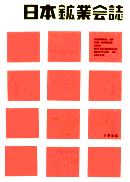All issues

Successor
Predecessor
Volume 76, Issue 868
Displaying 1-5 of 5 articles from this issue
- |<
- <
- 1
- >
- >|
-
Yoshiyuki HASHIGUCHI1960 Volume 76 Issue 868 Pages 663-665
Published: October 25, 1960
Released on J-STAGE: July 13, 2011
JOURNAL FREE ACCESSTne limonite doposits in Kamikita mine are consists of two types of ores, one may be regards oxidation of black-ore; the other may be secondary precipitated from ground water pass through the black-ore bodies.
Open pit mining was open in 1956 and about 150, 000 tons of are were produced.
By the reasons of heavy snow falls and cold weather in winter, anual operating times are only 5 months.(from June to Oct.) On 1959 some mechanization, such as power-shovel, bulldozers, and dump-trucks, were introduced into mining. After then mining expense is cutting downward.View full abstractDownload PDF (4632K) -
Shigeo NARITA, Shichiro HASHIMOTO1960 Volume 76 Issue 868 Pages 666-671
Published: October 25, 1960
Released on J-STAGE: July 13, 2011
JOURNAL FREE ACCESSIn this paper, the outline of open cut mining and mechanization in the Tsutsumizawa ore-deposits, Hanaoka mine is described.View full abstractDownload PDF (1192K) -
Narundo WADA1960 Volume 76 Issue 868 Pages 672-678
Published: October 25, 1960
Released on J-STAGE: July 13, 2011
JOURNAL FREE ACCESSOne reserves at outcrop of this deposit were estimated previously at 3 million tons, but chance of its development was not given for its low grade. To work on this development, we adopted a high efficiency method of open pit mining, as its production cost is lower than in underground mining. We began the development work in April 1957, and finished it in August 1959. By our plan, production is 1, 000t per day of 23% Fe ore, covering 10 years, and stripping ratio is 0.7. Main, equipment to maintain this production is comprised of 2 power shovels, 6 dump trucks, 3 bulldozers, 1-motor-grader and 9 heavy drifters. Number of miners is only 39.View full abstractDownload PDF (4560K) -
Toru SEKI1960 Volume 76 Issue 868 Pages 679-689
Published: October 25, 1960
Released on J-STAGE: July 13, 2011
JOURNAL FREE ACCESSTo speaking generally, the present condition of iron sand industry in Japan, the beach sand.deposit are almost worked out and the residual mine life are poor. So that it became that they could F not but develop the underground deposit in large scale.
For most of mine lots that belong to Tohoku Satestu Kogyo Co. bear these underground deposit, that we have mined those deposit since a few years, pushed the rationalization by mechanizing the mining and ore dressing, and we have reduced the production cost so much.
This theory discribes about the situation. of mining and ore dressing method in “Tengutai” such as a terrace deposit, and some studies about reformation and object in future.View full abstractDownload PDF (4155K) -
Isao NARA1960 Volume 76 Issue 868 Pages 690-694
Published: October 25, 1960
Released on J-STAGE: July 13, 2011
JOURNAL FREE ACCESSSri Medan iron Mine is situated in Johore State, Malaya. This mine is discovered by Mr. K. Ishihara in 1919 and out put amounted to about 10 million tons during the years from 1919 to 1941.
On account of the World War II, the mine was closed in 1941. However, its bauxite ore was mined on a small scale by the Japanese Army.
In 1952, the mine was reopened, and since then, its products have been sold to the Japanese Mills.
The deposits are composed of primary and secondary ore made up chiefly of hematite.
Owing to the under mentioned conditions, the opeu pit mining method has to be adopted,
(a) Lack of skillful mining laboures.
(b) The mechanization is easy and high efficiency can be expected.
(c) High extraction of ore can be expected.View full abstractDownload PDF (10272K)
- |<
- <
- 1
- >
- >|